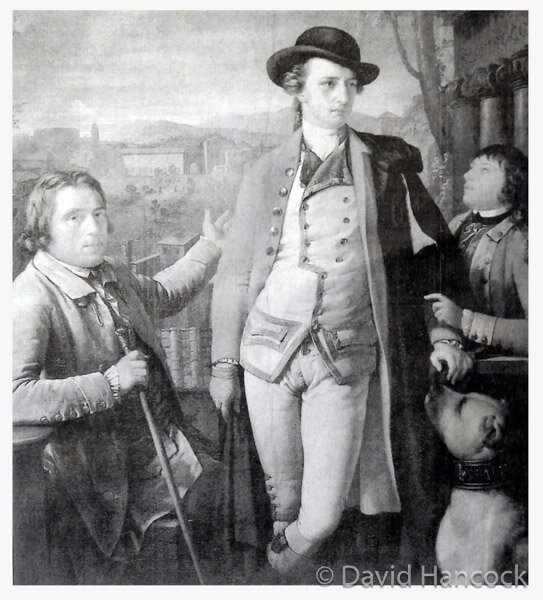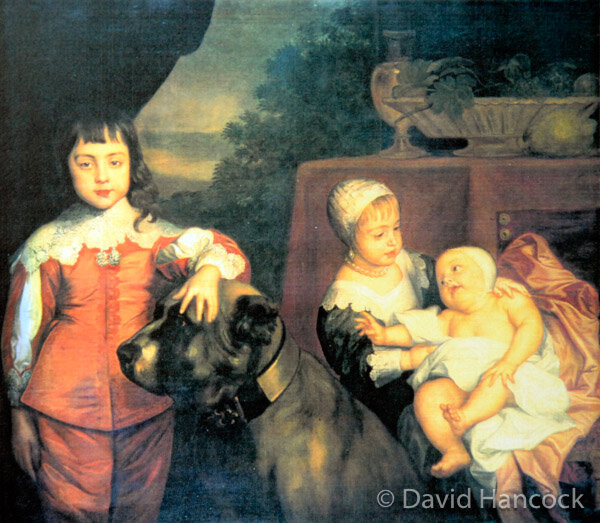1125
MASTIFFS - STATELY COMPANIONS
By David Hancock
The newly-rich of today, especially those making huge sums of money from the entertainment business, contribute very little to the promotion of our sporting and canine history, by failing to use their wealth and influence, as their predecessors in many great houses, like some of theirs, once did. The nobility and landed gentry, before, during and just after Victorian times had a huge influence on dogs in Britain, sporting breeds especially. There were 200 packs of Foxhounds, with the Duke of Beaufort and Lords Donerail, Portsmouth, Coventry and Bentinck, Sir William Curre, as well as prominent squires like Osbaldson, taking a keen interest. The Dukes of Gordon and of Richmond kept Deerhounds, as did Lords Seaforth, Tankerville and Bentinck. Lord Bagot showed Bloodhounds and Lord Wolverton ran a pack of them in Dorset, later sold to Lord Carrington in Buckinghamshire. The Marquis of Anglesea kept Harriers and Sir John Heathcote-Amory favoured Staghounds. Lord Lurgan's coursing Greyhound Master McGrath won 3 Waterloo Cups out of 4. The Duke of Atholl maintained a pack of Otterhounds. The Duke of Montrose, Lord Rank and Colonel Thornton promoted the Pointer. In Borzois, the Duchess of Newcastle promoted them and the Duchess of Manchester owned a huge specimen bred by Prince William of Prussia. The president of the KC was a duke, as was his vice.
In the non-sporting breeds, Lady Alexander favoured Collies, as did Princess de Montglyon. Lady Lewis and Lady Pilkington were members of the Bulldog Club, Lady Brassey is said to have introduced the black Pug to us. More famous in the Pug world were Lady Willoughby de Eresby and Lady Reid. The Duchess of Richmond promoted the Pekingese, with the 'Japanese Spaniels' drawing the support of the Countess of Malmesbury, Lady de Ramsey, Countess Wharncliff, Lady Probyn and the Countess of Warwick. Princess Sophie Duleep-Singh bred quality black Poms. In the terrier world, the Countess of Aberdeen patronised the Skye Terrier and the Duchess of Newcastle the Fox Terrier. The Mastiff was kept by any number of the nobility, the Earl of Oxford, the Marquis of Hertford and Lords Stanley and Waldegrave, for example. Of all the breeds of dog patronised by past members of the wealthy families, away from the sporting field, the breed of Mastiff stands supreme.
The association between large and often imposing houses and large and equally imposing dogs is a long and varied one. In the days when the nobility of Europe prided themselves on their horses and dogs, many famous breeds owed their origin to the dedicated, almost single-minded patronage of landed families. The royalty and aristocracy of Europe liked to have their portraits painted with their mastiff-like dogs, as the Batoni portrait of Sir Harry Fetherstonhaugh, the Della portrait of Kaiser Ferdinand II, the Van Dyck portrait of the children of Charles I and the Velazquez painting of Las Meninas illustrate, the latter featuring a cropped-eared Spanish Mastiff, a breed still existing today. The inherited sense of sporting history in the blood of such dynasties so often led to the stables and kennels being a prized feature of the family property. The architectural importance of purpose-built kennels such as those at Croxteth Hall in Liverpool and Lyme Hall near Manchester is now acknowledged. The fact that so many of these kennels no longer have dogs in them is disappointing.
Lyme Hall retains paintings of its mastiffs; Chatsworth and Nostell Priory retain the collars of their mastiffs. But how comforting it would be to see this ancient association revived by today's newly-rich. The Lyme Hall kennels are now empty but their Danish equivalents may soon be filling up with the mastiffs of Broholm Castle or Broholmers, now thankfully being resurrected. The Boerboel of South Africa, developed from the Bullenbijter of the Brabant - now divided between Belgium and Holland, also of mastiff type, is similarly being saved from extinction. Our own breed doesn't need saving from extinction but how good it would be to see these huge dogs back in favour at great houses. As William Youatt wrote, on the Mastiff, in his 'The Dog' of 1854: "He seems to be fully aware of the impression which his large size makes on every stranger; and, in the night especially, he watches the abode of his master with the completest vigilance..."
Mastiffs, eminent owners and historic houses coincide again and again when the development of today's Mastiff breed is researched. We can read of the Earl of Oxford's 'Lion', the Marquis of Hertford's 'Pluto', Lord Waldegrave's 'Turk' and 'Couchez', Sir Fermor Hesketh's 'Nero', Sir George Armitage's 'Tiger' and Sir E Wilmott's 'Lion'. As well as the celebrated Lyme Hall strain, we can discover an old line of pure Alpine mastiffs (probably smooth St Bernards) at Chatsworth and references to mastiffs at Elvaston Castle near Derby, Hadzor Hall near Worcester, Trentham Park near Stoke on Trent, Bold Hall in Lancashire, Esthwaite Hall in the Lake District and Nostell Priory in Yorkshire, Lord Stanley's dogs at Alderley and Athrington Hall's 'Lion'. Mastiffs and mansions were clearly closely associated and those at Lyme Hall hardly unique. Noble owners din't worship the pedigree either, as Stonehenge in his Dogs of the British Islands of 1872, quoting Capt Garnier’s letter, pointed out: “The mighty dogs which used to be kept at Chatsworth were pure Alpine Mastiffs, as also were the magnificent animals I have mentioned as having seen at Bill George’s kennels some sixteen years ago…I have spoken to people who have visited the convent, (i.e. the St Bernard’s, DH), and it appears that the monks have used another cross – the huge boarhounds found in Bavaria, the Upper Danube, and Tyrol.”
I suspect that the separation of noble families from their mastiffs had multiple causes, with two World Wars significant accelerators. But one rather sad reason could lie in the departure of the modern breed away from its historic mould as a heavy hound, used to pull down big game such as auroch, buffalo, boar and wild bull, and into a cumbersome unathletic overweight yard-dog. It is not historically correct to seek in this modern breed a dog weighing 180lbs, measuring 32" at the withers and lacking mobility, physical soundness, featuring sunken eyes and sagging lips. Morally, it is disgraceful to breed dogs with harmful exaggerations. Commercially, it is disastrous to breed dogs which attract huge veterinary bills. Compassionately, it is distressing to see dogs bred which only enjoy a limited lifespan and a restricted lifestyle. On these grounds I can understand any potential Mastiff owner, mansion-owner or not, looking elsewhere. As Frank Townend Barton, MRCVS, wrote in his 'Non-Sporting Dogs' of 1905: "Many recent winners have been somewhat of the degenerate type, but at the present time a reaction is setting in with a view to a revival of the grand old type of English Mastiff. This is as it should be, and there can be no doubt that these monarchs of strength and beauty will again become fashionable and find places in the stately halls of Great Britain and her dominions."
Nevertheless, the Mastiff, a magnificent breed of imposing stature and impressive temperament, is an important feature of our canine heritage and it would be good to see a remodelled breed, physically respecting its own ancestry, gracing the steps of great houses once again. Earlier this century, the Marquess of Londonderry and the Duke of Gloucester favoured the Bullmastiff, smaller and more athletic than their sister breed but strangely now being desired by some fanciers to be more mastiff-like. Fashion has destroyed more than one breed of dog but it would be good to see the Mastiff of England fashionable once again amongst mansion-owners. This is a breed of reassuring solidity, with noble bearing, an air of relaxed superiority yet possessing considerable reliability. They have much in common with the great houses they once adorned. Today a fabulously-wealthy pop-star could so easily not just restore a great house for the nation but restore too the once-traditional housing of our world-famous breed of Mastiff, so ruined by 19th and then 20th century show breeders. What a legacy to leave your country!
In his masterly British Dogs of 1888, the esteemed Hugh Dalziel wrote: "In recent years, a desire for immense bulk seems to have led exhibitors of Mastiffs to obtain this by fleshiness rather than increase of frame. This is done at a loss of symmetry and activity of action; and so over-fat are some Mastiffs when exhibited that, far from suggesting that they are a race of dogs of war, their appearance shows they would be of use only to the commissariat department of an army when besieged." Has anything changed in one hundred years? Breeders with courage, vision, skill and dedication to a breed and its heritage are now urgently needed if the next one hundred years are to see this magnificent breed restored to its former glory and hard-earned fame. What a superb challenge for any patriotic rock-star! Sic vos non vobis!

















